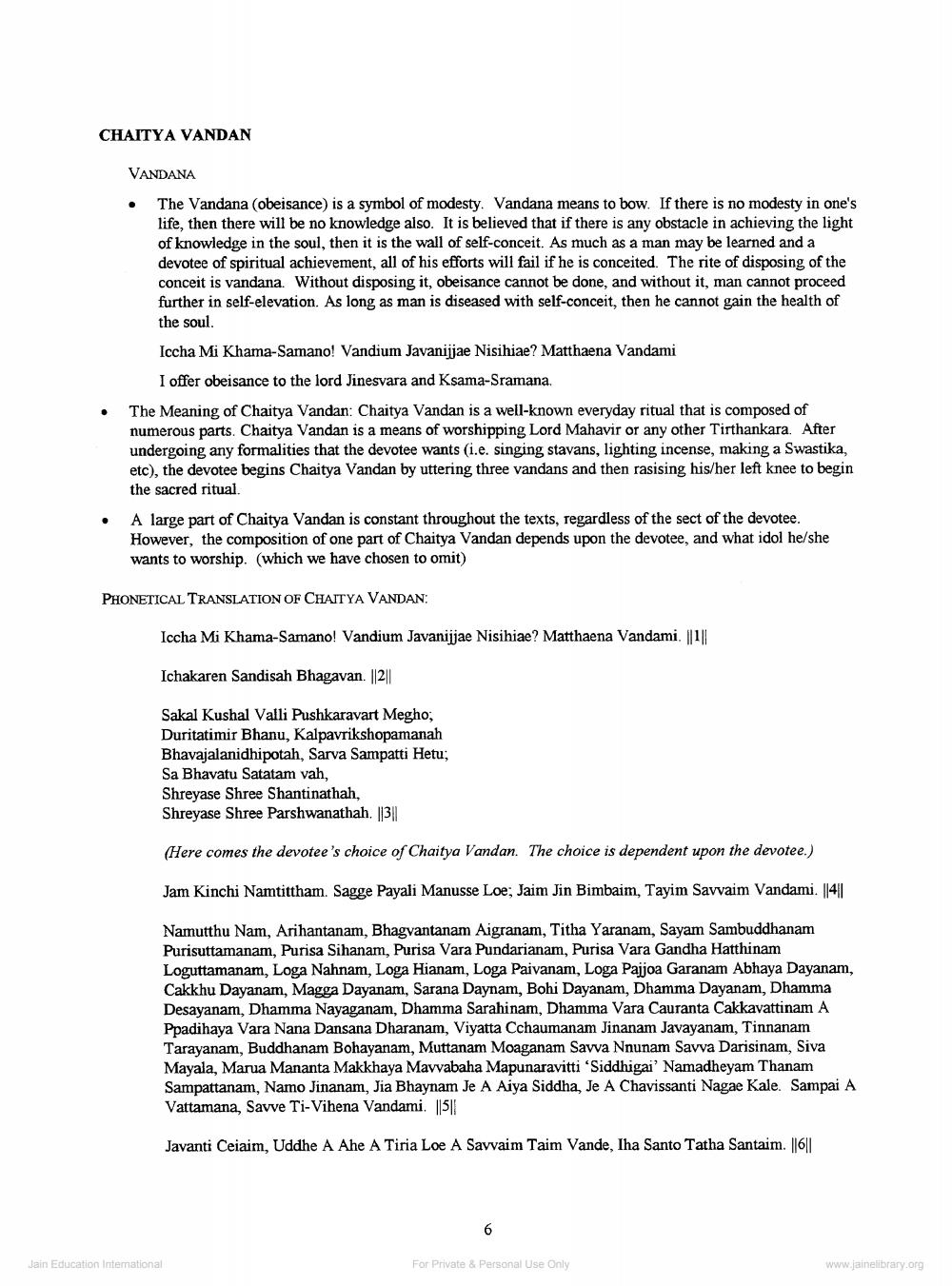________________
CHAITYA VANDAN
VANDANA
•
The Vandana (obeisance) is a symbol of modesty. Vandana means to bow. If there is no modesty in one's life, then there will be no knowledge also. It is believed that if there is any obstacle in achieving the light of knowledge in the soul, then it is the wall of self-conceit. As much as a man may be learned and a devotee of spiritual achievement, all of his efforts will fail if he is conceited. The rite of disposing of the conceit is vandana. Without disposing it, obeisance cannot be done, and without it, man cannot proceed further in self-elevation. As long as man is diseased with self-conceit, then he cannot gain the health of the soul. Iccha Mi Khama-Samano! Vandium Javanijjae Nisihiae? Matthaena Vandami I offer obeisance to the lord Jinesvara and Ksama-Sramana.
The Meaning of Chaitya Vandan: Chaitya Vandan is a well-known everyday ritual that is composed of numerous parts. Chaitya Vandan is a means of worshipping Lord Mahavir or any other Tirthankara. After undergoing any formalities that the devotee wants (i.e. singing stavans, lighting incense, making a Swastika, etc), the devotee begins Chaitya Vandan by uttering three vandans and then rasising his/her left knee to begin the sacred ritual.
A large part of Chaitya Vandan is constant throughout the texts, regardless of the sect of the devotee. However, the composition of one part of Chaitya Vandan depends upon the devotee, and what idol he/she wants to worship. (which we have chosen to omit)
PHONETICAL TRANSLATION OF CHAITYA VANDAN
Iccha Mi Khama-Samano! Vandium Javanijjae Nisihiae? Matthaena Vandami. ||1|||
Ichakaren Sandisah Bhagavan. ||2||
Sakal Kushal Valli Pushkaravart Megho; Duritatimir Bhanu, Kalpavrikshopamanah Bhavajalanidhipotah, Sarva Sampatti Hetu; Sa Bhavatu Satatam vah, Shreyase Shree Shantinathah, Shreyase Shree Parshwanathah. ||3|
(Here comes the devotee's choice of Chaitya Vandan. The choice is dependent upon the devotee.)
Jam Kinchi Namtittham. Sagge Payali Manusse Loe, Jaim Jin Bimbaim, Tayim Savvaim Vandami. 41
Namutthu Nam, Arihantanam, Bhagvantanam Aigranam, Titha Yaranam, Sayam Sambuddhanam Purisuttamanam, Purisa Sihanam, Purisa Vara Pundarianam, Purisa Vara Gandha Hatthinam Loguttamanam, Loga Nahnam, Loga Hianam, Loga Paivanam, Loga Pajjoa Garanam Abhaya Dayanam, Cakkhu Dayanam, Magga Dayanam, Sarana Daynam, Bohi Dayanam, Dhamma Dayanam, Dhamma Desayanam, Dhamma Nayaganam, Dhamma Sarahinam, Dhamma Vara Cauranta Cakkavattinam A Ppadihaya Vara Nana Dansana Dharanam, Viyatta Cchaumanam Jinanam Javayanam, Tinnanam Tarayanam, Buddhanam Bohayanam, Muttanam Moaganam Savva Nnunam Savva Darisinam, Siva Mayala, Marua Mananta Makkhaya Mavvabaha Mapunaravitti 'Siddhigai' Namadheyam Thanam Sampattanam, Namo Jinanam, Jia Bhaynam Je A Aiya Siddha, Je A Chavissanti Nagae Kale. Sampai A Vattamana, Savve Ti-Vihena Vandami. ||5||
Javanti Ceiaim, Uddhe A Ahe A Tiria Loe A Savvaim Taim Vande, Iha Santo Tatha Santaim. |16||
Jain Education International
For Private & Personal use only
www.jainelibrary.org




